CoreMark processor rating
Picking up a new desktop has faced the chaos of various estimates of the speed of the system. And it seems that everyone has long known that a bundle of components should be selected according to the principle of “sea convoy” - the total speed of the convoy is determined by the slowest ship, which is the exchange rate between the CPU, RAM blocks and the interlayer in the form of chipsets. However, due to very steep changes on the processor front, for me everything is not so objective, and I associate the greatest amount of misunderstanding with processor chips. On the one hand, the market goes after servers, multithreading and an increase in the number of cores, the exchange rates between components increase many times, on the other hand, software is slowly optimized for multiprocessing, with the exception of mathematical and engineering packages that are really able to load all the cores entirely. Over the past 5 years, the architecture of the ordinary desktop processor itself has changed, although the data bus did not overcome 64 bits, the Intell Haswell generation acquired a high-performance ring bus, after the conveyor and HT, I personally consider it a new evolution of central microprocessors on the PC platform, which is coupled with reorientation Green Technology manufacturers and low consumption should finally lead the market to new high-performance and energy-efficient solutions. Here I also would like to hear about the last from users of Habr, as at the most knowledgeable audience.
The following link , leading to the page with a rating of processors, gives one comment that interests me. Verbatim quote:
Agree, the amount of electricity in the world is strictly limited by the number of power plants that are not very often commissioned, the growth of electricity tariffs is observed everywhere, and the volume of microprocessors in the hands of the population and owned by enterprises grows like an avalanche. The overall situation is most vividly expressed by data centers in which the cost of fixed assets in the form of a server fleet is small compared to the total cost of powering racks and the operation of cooling systems. Hence, there naturally arises the need to derive an adequate processor rating adjusted for TDP / Mhz for ordinary consumers without having to climb into each datasheet separately and waste time. Another thing is a secret between us, consumers rarely look at the TDP. Just tcc ...
What remains for me, what processor should I focus on? For a start, it would be nice to look at the overall rating of ALL mainstream solutions on the market, or almost all. Let's get started As is clear from the title, I used the CoreMark database. Before you register, you can go through this procedure as you download the source of the test itself:

')
Then, choosing vendors,
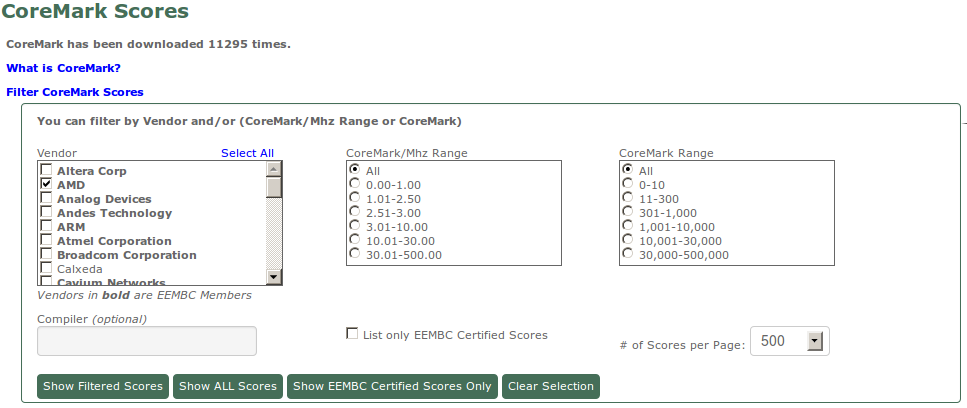
You can contemplate such nice tablets (please pay special attention to the number of threads):
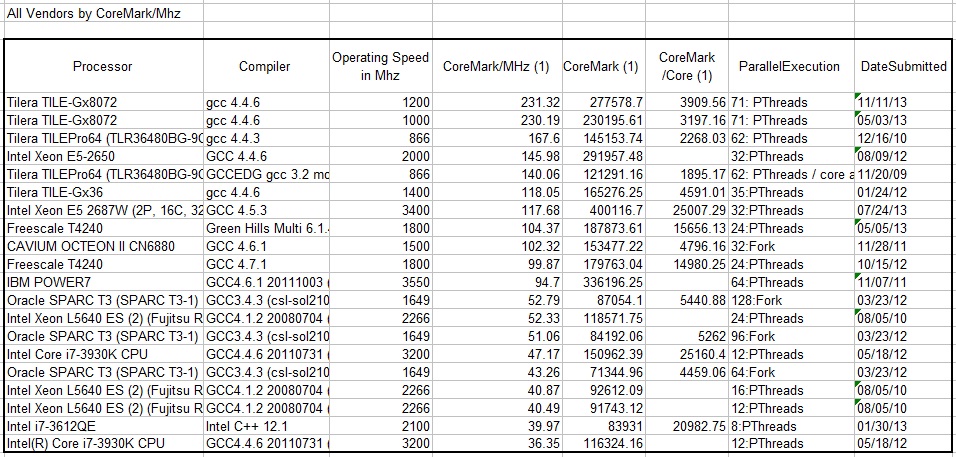
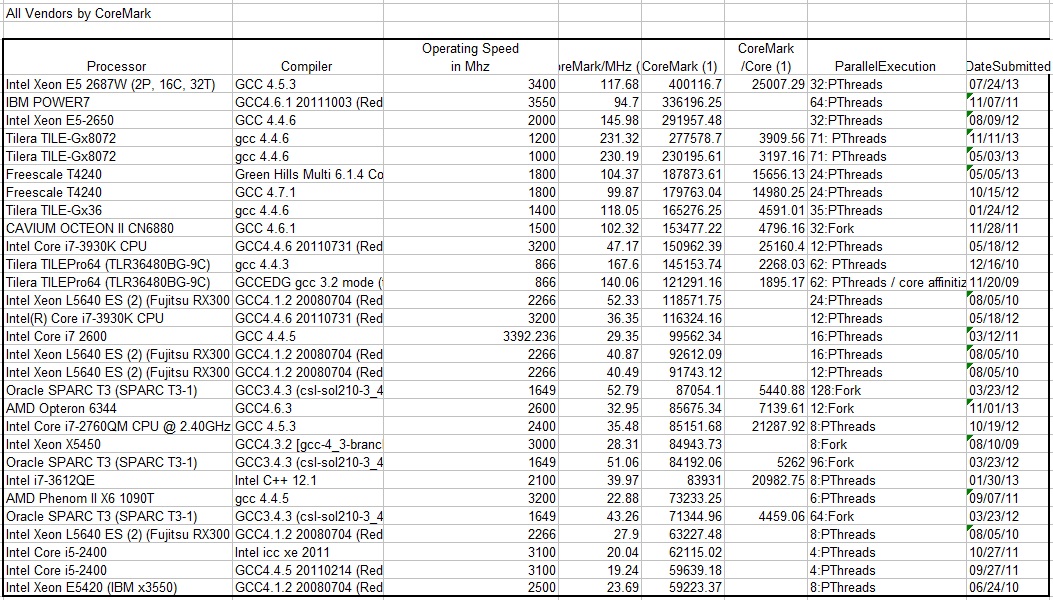
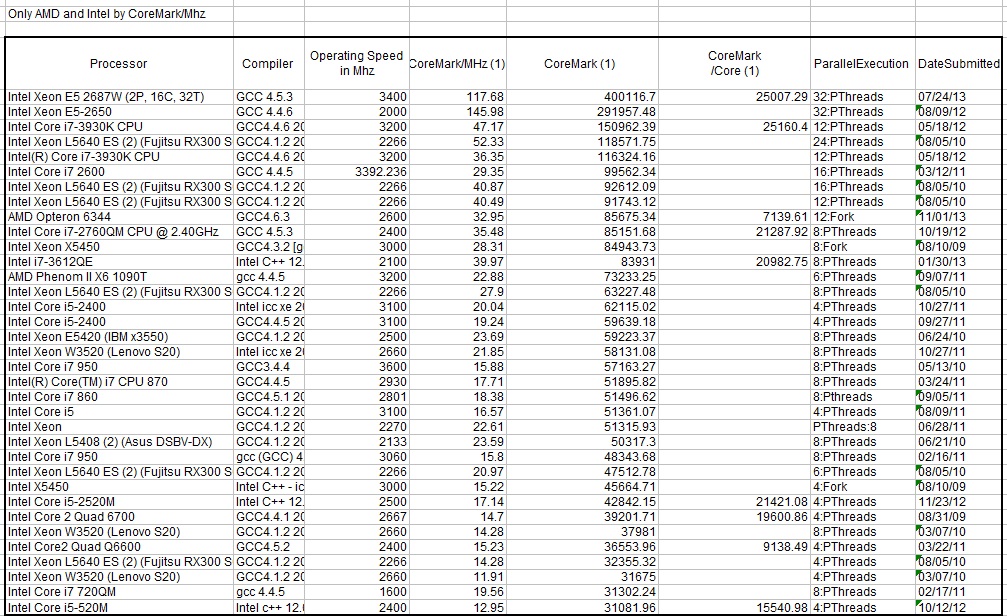
Along the way, I rated the Atom N455 by unpacking the sent source code for the coremark_v1.0.tgz test and typing
Now I just had to look for information about the current desktop flagships:
And also consider TDP:
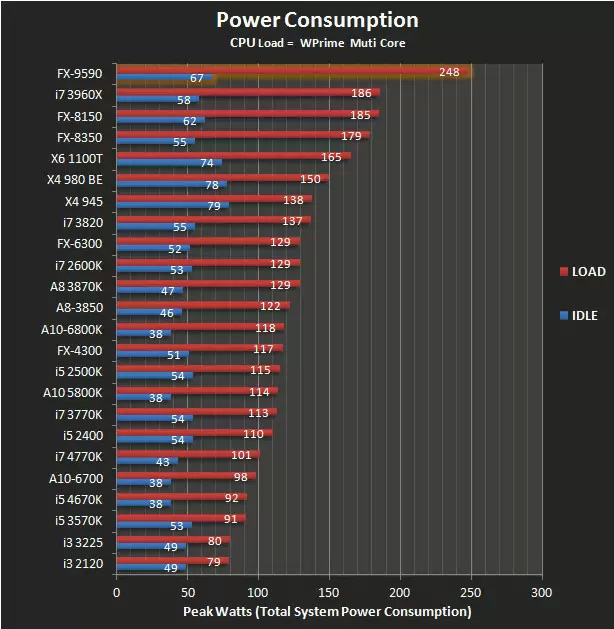
Results: the current situation with ratings looks quite one-sided and personally does not suit me at all. Instead of a handful of pages scattered on the Internet, I would like to see the combination in one final table of the total figure of performance, energy efficiency and specific return on the purchase amount. But while manufacturers and marketers darken have to reinvent the wheel. I would very much like to see a different point of view in your comments and still see this table live. Thanks for attention.
The following link , leading to the page with a rating of processors, gives one comment that interests me. Verbatim quote:
“There are many tables on the Internet with comparative characteristics of processors. But it’s very hard to find tables comparing architectures. There is such a rarely used parameter DMIPS / MHz. This parameter shows the specific performance per cycle. This option allows you to understand whose architecture is the most efficient and has the best odds. For example, processors based on ARM cores are compared precisely in specific performance. And in specific performance, they are better than Intel processors. This means that if Samsung makes the processor with the ARM core for the next iPhone using the most modern technology of 22 nm, then they will have a processor with better characteristics than the most modern Intel processors. The second important parameter for comparing architectures is DMIPS / Watt performance. Allows you to evaluate the power consumption of the architecture. The less power a processor requires, the more chances it has for using it in mobiles (phones, tablets) or vice versa in super-large systems (supercomputers). It would be very nice if at least one Internet media made an extensive table on the old and new architectures of various (not only Intel, AMD or ARM) processors. ”
Agree, the amount of electricity in the world is strictly limited by the number of power plants that are not very often commissioned, the growth of electricity tariffs is observed everywhere, and the volume of microprocessors in the hands of the population and owned by enterprises grows like an avalanche. The overall situation is most vividly expressed by data centers in which the cost of fixed assets in the form of a server fleet is small compared to the total cost of powering racks and the operation of cooling systems. Hence, there naturally arises the need to derive an adequate processor rating adjusted for TDP / Mhz for ordinary consumers without having to climb into each datasheet separately and waste time. Another thing is a secret between us, consumers rarely look at the TDP. Just tcc ...
What remains for me, what processor should I focus on? For a start, it would be nice to look at the overall rating of ALL mainstream solutions on the market, or almost all. Let's get started As is clear from the title, I used the CoreMark database. Before you register, you can go through this procedure as you download the source of the test itself:

')
Then, choosing vendors,

You can contemplate such nice tablets (please pay special attention to the number of threads):



Along the way, I rated the Atom N455 by unpacking the sent source code for the coremark_v1.0.tgz test and typing
make PORT_DIR=linux XCFLAGS="-g -DMULTITHREAD=2 -DUSE_FORK=1" for 2 threads in the console. The result in the 4500 quite accurately fit into the big picture. Details of the test.Now I just had to look for information about the current desktop flagships:
Powerful processors of 2014 and the conditional rating of performance (as amended by dxdigitals.info ):
Intel Core i7-4765T 50.4
Intel Core i5-4670K 56.7
Intel Core i5-4670 57.2
Intel Core i7-4770T 59.7
Intel Core i7-3770S 63.1
Intel Core i7-3820 63.8
AMD FX-9370 64.5
Intel Xeon E3-1240 V2 65.4
Intel Core i7-3770 66.2
Intel Core i7-3770K 67.3
Intel Core i7-4820K 67.4
AMD FX-9590 68.5
Intel Core i7-4771 69.7
Intel Core i7-4770 72.4
Intel Core i7-4770K 72.5
Intel Core i7-3930K 87.5
Intel Core i7-3970X 94.2
And also consider TDP:

Results: the current situation with ratings looks quite one-sided and personally does not suit me at all. Instead of a handful of pages scattered on the Internet, I would like to see the combination in one final table of the total figure of performance, energy efficiency and specific return on the purchase amount. But while manufacturers and marketers darken have to reinvent the wheel. I would very much like to see a different point of view in your comments and still see this table live. Thanks for attention.
Source: https://habr.com/ru/post/225853/
All Articles